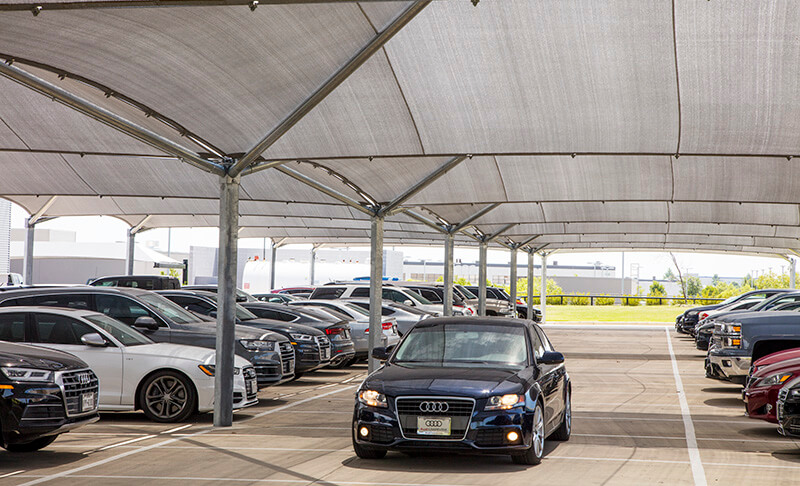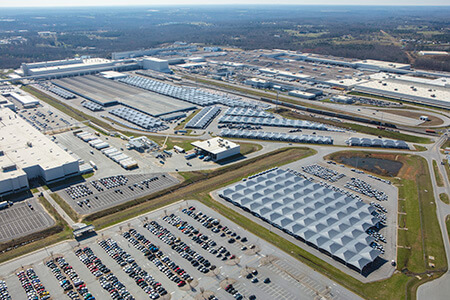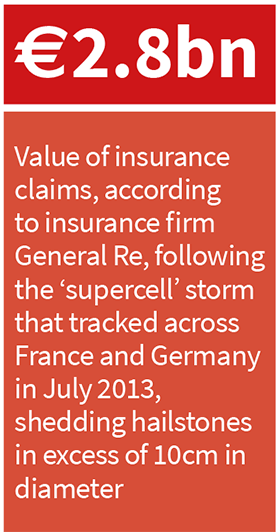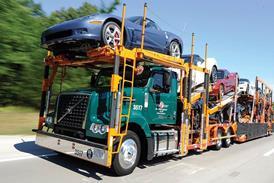 In late August 2017, Hurricane Harvey – the storm that devastated the Caribbean, flattening Puerto Rico – made landfall on the Texas coast. The second-costliest tropical cyclone on record and the third hurricane of the exceptionally active 2017 hurricane season, it inflicted a reported $125 billion in damage and, according to Forbes magazine, destroyed over a million vehicles, mostly through flooding.
In late August 2017, Hurricane Harvey – the storm that devastated the Caribbean, flattening Puerto Rico – made landfall on the Texas coast. The second-costliest tropical cyclone on record and the third hurricane of the exceptionally active 2017 hurricane season, it inflicted a reported $125 billion in damage and, according to Forbes magazine, destroyed over a million vehicles, mostly through flooding.
Relatively few of these were new vehicles in transit, however. Armed with advance warning of the impending storm, logistics service providers, vehicle manufacturers and port operators were able to move vehicles away from the areas most at risk, expedite vehicle processing to empty their compounds, and delay incoming shipments until the storm had passed.
[related_topics align="right" border="yes"]But just over a year later, the south-eastern US was hunkering down again as Hurricane Florence – a so-called ‘storm of a lifetime’ – came sweeping in over North Carolina. A million people were placed under mandatory evacuation orders, as high winds and flooding from storm surges and exceptional rainfall were predicted. Again, the industry was set to escape relatively lightly: no major vehicle ports or manufacturing facilities lay in its direct path.
Yet the world’s automotive industry is not always so fortunate. Back in 2011, severe flooding simultaneously hit seven of Thailand’s largest industrial zones, causing shutdowns at plants belonging to Japanese vehicle-makers Toyota, Honda, Mitsubishi, Isuzu and Nissan, and causing the country’s industrial output to fall by 36% in a single month. Supply chain disruption was felt worldwide, with plants in Asia, North America and Europe hit by parts shortages – and in many cases, production took months to restart.
 More recently, in June 2018, a Honda plant in Celaya, Mexico, was flooded. Still closed at the time of writing, it was expected to be November – five months later – before production there resumed.
More recently, in June 2018, a Honda plant in Celaya, Mexico, was flooded. Still closed at the time of writing, it was expected to be November – five months later – before production there resumed.
Hail, as the industry knows to its cost, is another expensive weather-related problem. In July 2013, a ‘meteorologically extreme’ period of prolonged hot weather in central Europe left the region vulnerable to violent thunderstorms. Sure enough, a massive storm system tracked across France and Germany in late July, leaving flooding and hail damage in its wake, and developing a ‘supercell’ as it met the hotter air over southern Germany’s Black Forest region. Hailstones well over 10 centimetres (yes, centimetres) in diameter were recorded.
In its path lay the vehicle compounds at Volkswagen’s Wolfsburg plant, where 28,000 cars sat awaiting shipment. Thousands of these were left with broken windscreens, dents, dings and scratches after being hit by the supercell’s exceptionally large hailstones. The €2.8 billion ($3.25 billion) of damage made it the most expensive hailstorm in Germany’s history and the world’s single most expensive event for the insurance industry in 2013, according to insurance underwriters Stefan Woppowa and Michael Odenhausen at General Re.
Globally, extreme weather events are not uncommon, of course. And in part, they are why carmakers and their logistics service providers buy insurance: in hurricanes, tornadoes, floods, hail, and even sandstorms, a compound full of new cars represents a highly concentrated and expensive hostage to fortune. The 2008 hailstorm that hit 30,000 vehicles parked in the open at the German port of Emden, for instance, caused millions of dollars of damage and created significant supply chain disruption.
Claims on the riseIt is not clear whether such extreme weather events are really becoming more frequent. But that possibility, says Tim Doonan, New York-based senior vice-president of Tokio Marine Claims Service, is the nagging suspicion currently keeping the insurance industry awake at night.
“Insurance industry statistics document a definite increase in storm losses, with the frequency of loss-related natural disasters almost tripling since 1980 and registered insurance losses increasing by about 25% over the last five years,” he notes. “For the automotive industry, flood events have seen the most dramatic increase in frequency and represent the highest economic losses over the last five years, but hail damage, and damage from windborne debris, have also increased.”
Independent scientific studies show a similar picture, adds James Sadlier, director of claims agent and risk adviser Sevatas. A 2013 study by the European Academies’ Science Advisory Council, 'Extreme weather events in Europe: preparing for climate change adaptation', he points out, suggests that four times as many floods now occur worldwide as in 1980. The European Severe Weather Database also suggests an increase in severe hailstorms.
"Statistics document a definite increase in storm losses, with the frequency of loss-related natural disasters almost tripling since 1980 and registered insurance losses increasing by about 25% over the last five years." - Tim Doonan, Tokio Marine Claims Service
“The automotive industry is altering its stance to weather-related events, but probably not quickly enough,” says Sadlier. “Every event is effectively being treated as a single occurrence, and may be better being viewed as an accumulation of risk over longer periods, which is similar to the insurers’ own view. Awareness is growing, but beyond some basic ‘catastrophic loss’ planning, there is little preventative work or investment being undertaken, and most work is reactive, [taking place] after an event has occurred.”
Reluctance to engageOne thing that will not have helped the industry to formulate a more effective response to extreme weather is the growing politicisation of climate change, suggests Hans-Bert Bong, director of Köln-based independent finished vehicle logistics consultancy Dr. Bong Business Consulting.
“The industry is used to making decisions based upon facts and measurements, but climate change is more of a belief and that makes it uncomfortable,” says Bong, who has 25 years’ experience at Ford. “The impact of weather is a major problem for the industry, but it’s one that is both far removed from manufacturers’ core competencies and that has growing political overtones. Not surprisingly, it is proving to be an awkward issue to engage with, even though temperatures are rising – and few people deny that.”
Given the expense and disruption for supply chains created by extreme weather events, such a reluctance to engage is surprising. None of the vehicle manufacturers or compound operators Automotive Logistics contacted for this article were willing to speak on the record about extreme weather events and their impact on their supply chains. In an era when governments and significant numbers of voters think climate change is a fraud, such reticence is perhaps understandable. More damningly, suggest some observers, there is a tendency to pay lip-service to the need to respond to a greater incidence of extreme weather events, while at the same time relying on insurance as protection against catastrophic loss.

“Very few auto-makers want to openly discuss extreme weather and responses to it such as forecasting or mapping risk, improved hail protection, and evacuation plans for floods or hurricanes, which are all actions that cost them money,” says one insider. “They prefer to regard natural catastrophes as ‘acts of God’ for which the only protection is insurance.”
Even so, were those natural catastrophes to increase in frequency or severity, then eventually insurers’ patience would be tested to breaking point – at which point, increased premiums and rising deductibles, coupled with a greater insistence on protective measures, would force the unavoidable issue of extreme weather out into the open.
As Sevatas’ Sadlier notes, given that car manufacturers’ decisions about where to place their insurance business are often price-driven, rather than risk-driven, it is only logical to expect tightening profit margins in the insurance industry to result in insurers insisting on more protective measures within the supply chain, and more active human intervention, in order to limit the risks they underwrite.
“Increasingly, driven by their insurers, the automotive manufacturers will require particular actions, changes to storage environments, and specific assurances from their lead service providers – in other words, risk management, as well as risk removal,” he states. “Human agency still has a part to play, and aligning best practice and a specific storage environment can have dramatic effects in limiting losses: as well as natural risks, one of the most significant contributors to increased loss is complacency.”
Global forecast heats upThe tipping point at which increasing risks start to have that effect may be coming sooner, rather than later. Whatever one’s stance on climate change – real or imagined, man-made or not – the science of rising temperature is both well understood and accessible to anyone with a secondary school-level understanding of science. And no one – not even the present American administration – disputes that average global temperatures are rising.
[mpu_ad]At the UK’s government-owned national weather service, The Met Office, meteorologist Grahame Madge sums it up well. The average long-term historical temperature globally has risen by about 1°C, he points out, and a warmer atmosphere contains more energy and more moisture – a combination that leads to an increase in extreme weather events.
“We have a large, high-performance computing centre, a sophisticated and high-definition climate model, and an unbroken weather record going back to 1910 for the whole of the United Kingdom, and 1659 for central England. We’ve undertaken two studies into the effect that rising temperatures will have on the United Kingdom, and we expect to see more extreme levels of rainfall, more concentrated rainfall, with historical extremes being breached every few years,” he notes. “Nationally, we’re looking at increased heatwaves, increased flooding and, potentially, an increased incidence of hailstorms.”
However, Bill Gail, chief technology officer at Boulder, Colorado-based private weather service Global Weather Corporation (which provides the forecasts behind Yahoo Weather, as well as forecast data to The Weather Channel for renewable energy and data outputs to AccuWeather that are used as a component in constructing forecasts), notes that putting precise parameters on the frequency, scale and footprint of extreme weather events is difficult, especially on a global scale.
“Extreme weather events are indeed becoming more common; there is no doubt that the science community believes weather events will be more extreme and that, in theory, we will see more violent precipitation events of both rain and hail,” he says. “But making statements about frequency or scale is complex – although ongoing research is bringing that point nearer.”
What can be said, he adds, is that while modelling the effects of a changing climate is difficult, the much simpler business of making short-term forecasts has made enormous advances in recent years, thanks to high-powered computers and better climate models.
“In general, forecasting skill has been increasing by about one day per decade: what we could predict three days out a decade ago has now increased to four days – and the use cases of what can be done with those extra days of visibility continue to mount,” he explains. “For the automotive industry, four or five days’ notice to move 10,000 cars might be a significant opportunity. But in general, our sense is that the industry doesn’t really yet appreciate the accuracy attainable with today’s forecasting technology.”
 Keeping vehicles under cover is obviously the best way to protect them from hailstorms
Keeping vehicles under cover is obviously the best way to protect them from hailstormsIt seems reasonable, then, to expect a two-fold response to extreme weather: a greater insistence by insurers on the adoption of protective measures and a greater reliance on what might be termed reactive measures, driven by more accurate weather forecasts and a generally heightened level of preparedness. Both, perhaps handily, can be pitched to shareholders and consumers as data-driven responses to a measured increase in extreme weather events, as well as the emergence of newer and more accurate approaches to forecasting. Neither requires any explicit linkage with climate change, man-made or not.
By way of example, consider the heavy rains which affected western Japan in July this year, causing flooding and loss of life. While plants operated by Nissan and Mazda were temporarily shut down, production losses were relatively limited. At Mazda, explains Osamu Tominaga, the carmaker’s general manager of production control and logistics, this was due to the combination of contingency planning and advance warning from national weather agencies and the private weather forecasting services to which the firm subscribes.
“When the Great East Japan Earthquake occurred in 2011, it took up to two weeks to fully understand the situation as it affected our business partners,” he notes. “Based on the lessons learned from that experience, we implemented a supply chain risk management system that enables us to very quickly identify those business partners likely to have been affected when a natural disaster occurs. And thanks to this system, we had a good understanding of the situation at affected business partners, which helped to facilitate an early recovery.”
 Protective measures on the upInterest in protective measures is growing, too. Newton Wimer, owner of Newton Systems International, a manufacturer of hail cannons, sees a definite increase in demand for the company’s devices. But he adds that the industry isn’t always helping itself, by siting manufacturing plants in areas where either the climate or the local topography lends itself to hail (although there are obviously good reasons for selecting a particular place, notably the ‘build-where-you-sell’ concept). He says that, generally speaking, plants located in tropical areas can expect more hail events than facilities in more temperate ones.
Protective measures on the upInterest in protective measures is growing, too. Newton Wimer, owner of Newton Systems International, a manufacturer of hail cannons, sees a definite increase in demand for the company’s devices. But he adds that the industry isn’t always helping itself, by siting manufacturing plants in areas where either the climate or the local topography lends itself to hail (although there are obviously good reasons for selecting a particular place, notably the ‘build-where-you-sell’ concept). He says that, generally speaking, plants located in tropical areas can expect more hail events than facilities in more temperate ones.
“Our main market used to be the western part of the US, but now we’re seeing a lot of interest from car manufacturers overseas,” he notes. “The best solution for hail is to place a physical barrier between the vehicle and the hail, such as hail nets or shelters, but that isn’t always a financially justifiable proposition.”
But if the frequency and severity of extreme weather turns out to be as significant a problem for the industry as some fear, then those business cases and justification criteria will need to be rethought. And that review process may be further advanced than is widely thought.
“Our logistics people are aware of extreme weather as a problem and are looking at a workable solution,” admits one global automotive manufacturer who prefers to remain anonymous. “Unfortunately, it is still too early to communicate what that solution might be.”
"The impact of weather is a major problem for the industry, but it’s one that is both far removed from manufacturers’ core competencies and that has growing political overtones." - Hans-Bert Bong, Dr. Bong Business Consulting
 Extremes of convective weather – when cold air masses and hot air masses meet, causing major updrafts – can create hail storms. And as the costs of hail damage mount, the demand for physical hail shelters is also increasing.
Extremes of convective weather – when cold air masses and hot air masses meet, causing major updrafts – can create hail storms. And as the costs of hail damage mount, the demand for physical hail shelters is also increasing.
Twenty years ago, American manufacturer Vehicle Protection Structures’ focus was solely the US south-west; now, says senior vice-president Wade White, there is strong international interest in the company’s structures as well.
Following recent installations at car plants in Germany, Spain, and Belgium, the company has bid for several European projects recently and has designed a solution expressly for European weather. Snow loads and wind loads are a little lighter in Europe than in North America, he notes, and it is possible for lighter – and therefore cheaper – structures to deliver sufficient protection. However, erecting physical structures will always cost more than hanging up hail nets or buying a hail cannon.
“Physical structures can almost completely mitigate the risk of hail damage and we are seeing a growing acceptance of that message in the marketplace. Extreme convective weather isn’t going to go away any time soon, and at a cost of $20-60 per square metre, physical structures deliver better protection than any other solution out there.”
There might be a way to soften the blow of such expense, too, suggests consultant Hans-Bert Bong. Since physical structures create roofs, the use of solar panels on those roofs would help offset the construction costs by generating power.
“Why build on green fields, when acres of compound already exist?” he asks. “Solar panels change the business case, and allow auto manufacturers to boost their green credentials.”























